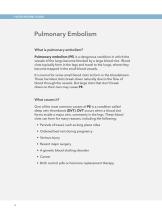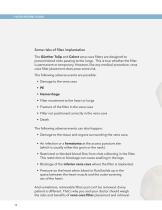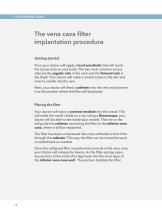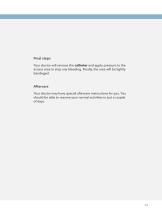
Catalog excerpts

Cook Celect® and Günther Tulip® Vena Cava Filter Patient Guide
Open the catalog to page 1
Filter patient guide Pulmonary embolism What is pulmonary embolism? What causes it? What are the symptoms of PE? Your Cook Medical vena cava filter What a filter can and cannot do When vena cava filters are used Types of filters Material and design Vena cava filter retrieval Who should not receive a vena cava filter? Risks and benefits of filter implantation The vena cava filter implantation procedure Getting started Placing the filter Final steps Aftercare The filter retrieval procedure
Open the catalog to page 2
Will my filter be permanent or will it be taken out? The filter retrieval process Frequently Asked Questions 16-17 Your patient card 22 - 23
Open the catalog to page 3
Filter patient guide Pulmonary Embolism What is pulmonary embolism? Pulmonary embolism (PE) is a dangerous condition in which the vessels of the lungs become blocked by a large blood clot. Blood clots typically form in the legs and travel to the lungs, where they become trapped in the small blood vessels. It's normal for some small blood clots to form in the bloodstream. These harmless clots break down naturally due to the flow of blood through the vessels. But large clots that don't break down on their own may cause PE. What causes it? One of the most common causes of PE is a condition...
Open the catalog to page 4
What are the symptoms of PE? The symptoms of PE can vary based on where the clot is located in your body. The most common symptoms include: • Shortness of breath, often with mild exertion. This can damage your lungs and cause heart failure or even death. • Chest pain that becomes worse with exertion but does not go away when you are at rest. • Coughing that produces blood or blood-tinged mucus.1 Experts estimate that up to 600,000 people suffer from PE every year. Most are caused by DVT. About one in three of these people may die if they are not treated.2 However, that rate drops to less...
Open the catalog to page 5
Filter patient guide Your Cook Medical vena cava filter What a filter can and cannot do A vena cava filter doesn't keep blood clots from forming. Instead, it is designed to trap blood clots as they travel through the inferior vena cava (IVC). The IVC is a large vein that drains blood from the lower body to the heart. A filter is important because clots that reach the lungs can be deadly. Clots can block blood flow to the lungs. They can also reduce the body's oxygen levels and put stress on the heart. A vena cava filter is made of very thin wire. It acts as a tiny strainer, trapping large...
Open the catalog to page 6
When a vena cava filter might be used You might get a vena cava filter if you have already had PE and any of the following statements are true: • You can’t use anticoagulant therapy. • Anticoagulant therapy hasn’t worked in the past to treat your blood-clot problem. • You had massive PE that needed emergency treatment. • You have had more than one PE event and anticoagulant therapy has not been effective or is not recommended for you. The following situations can also put you at risk for PE: • Bariatric surgery • Cancer treatments • A motor vehicle accident or other trauma • ...
Open the catalog to page 7
Filter patient guide Types of Filters Cook Medical makes two types of retrievable vena cava filters: the Günther Tulip® Vena Cava Filter and the Celect® Vena Cava Filter. Both filters are known as “optional” filters. This means they may be removed after your doctor thinks the danger of PE has passed. However, these filters can also remain in place as permanent devices. The Günther Tulip has been offered in the U.S. since 2000, and the Cook Celect has been offered here since 2007. Cook filters have been implanted in hundreds of thousands of patients worldwide. Material and design Both...
Open the catalog to page 8
Who should not receive a vena cava filter? You should not receive a vena cava filter if either of the following statements is true: • Your doctor tells you that your inferior vena cava is not the right size for a filter. • You are at risk of septic embolism (a type of blood-vessel blockage that can occur when pus-forming bacteria or other infectious organisms are in the bloodstream). When should the filter be left in place? The Günther Tulip and the Celect Vena Cava Filter should not be retrieved if: • More than 25% of the space inside your filter contains trapped blood clots. Even if...
Open the catalog to page 9
Filter patient guide Some risks of filter implantation The Günther Tulip and Celect vena cava filters are designed to prevent blood clots passing to the lungs. This is true whether the filter is permanent or temporary. However, like any medical procedure, vena cava filter placement does pose some risk. The following adverse events are possible: • Damage to the vena cava • PE • Hemorrhage • Filter movement to the heart or lungs • Fracture of the filter in the vena cava • Filter not positioned correctly in the vena cava • Death The following adverse events can also happen: • Damage to...
Open the catalog to page 10
The Cook Celect Vena Cava Filter capturing a clot.
Open the catalog to page 11
Filter patient guide The vena cava filter implantation procedure Getting started First, your doctor will apply a local anesthetic that will numb the access area on your body. The two most common access sites are the jugular vein in the neck and the femoral vein in the thigh. Your doctor will make a small incision in the skin and insert a needle into the vein. Next, your doctor will feed a catheter into the vein and advance it to the position where the filter will be placed. Placing the filter Your doctor will inject a contrast medium into the vessel. This will make the vessel visible on...
Open the catalog to page 12
Final steps Your doctor will remove the catheter and apply pressure to the access area to stop any bleeding. Finally, the area will be lightly bandaged. Aftercare Your doctor may have special aftercare instructions for you. You should be able to resume your normal activities in just a couple of days.
Open the catalog to page 13All COOK Medical catalogs and technical brochures
-
LITHO-60
16 Pages
-
Litho 100
16 Pages
-
Physician’s
92 Pages
-
Nester Embolization Coils
4 Pages
-
HiWire
2 Pages
-
Flexor Ansel Guiding Sheath
4 Pages
-
EUS 3 Needle
12 Pages
-
Simplifying Hemostasis.
6 Pages
-
Universa® URETERAL STENT SET
8 Pages
-
Motion™ HYBRID WIRE GUIDE
4 Pages
-
PROCESS SPECTRUM CATHETERS
4 Pages
-
Physician’s pocket reference guide
132 Pages
-
Surgical Melker
2 Pages
-
DIFFICULTS AIRWAY PRODUCTS
16 Pages
-
Beacon Tip
4 Pages
-
Products for Dialysis
15 Pages
-
Royal Flush Plus
4 Pages
-
Ureteral Stent Drainage
3 Pages
-
Fusion ® Zilver
2 Pages
-
BENCHTOP INCUBATOR
4 Pages
-
FISTULA BRUSH
2 Pages
-
PERCUTANEOUS DRAINAGE PRODUCTS
32 Pages
-
Fusion ®
2 Pages
-
Centesis and Drainage Products
20 Pages
-
ENDOVASCULAR DILATOR SET
2 Pages
-
Zenith
2 Pages
-
Salivary Stone Extractors
4 Pages
-
EchoTip®
2 Pages
-
Hercules ®
2 Pages
-
Biodesign®
2 Pages
Archived catalogs
-
Hemostasis Family
6 Pages




























































